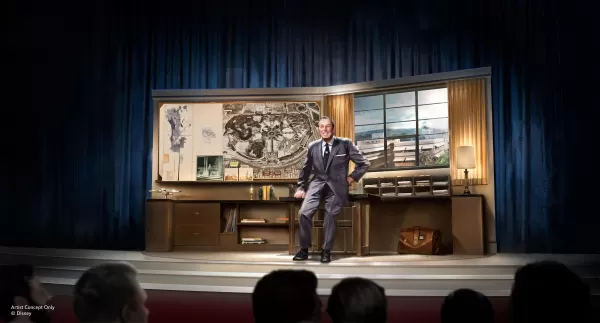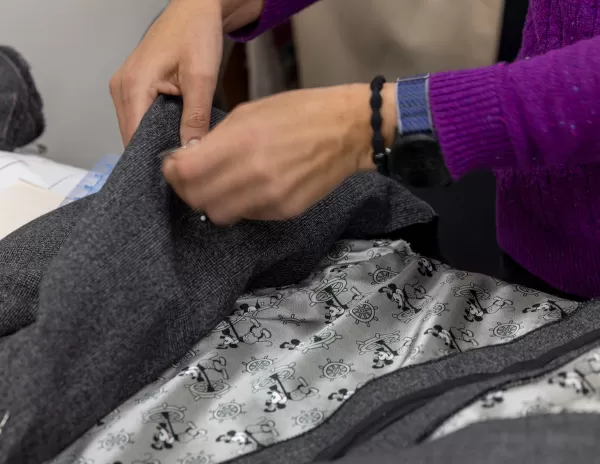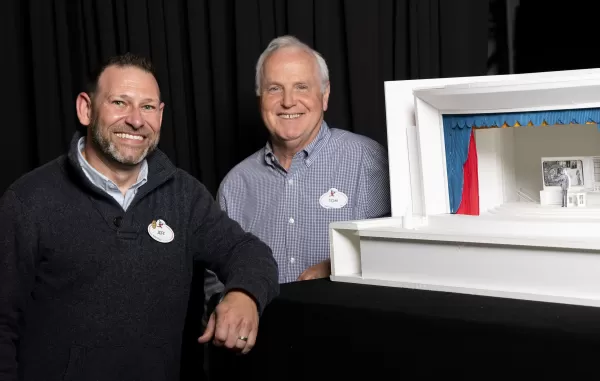Disney invited us and a few select guests behind the scenes at Walt Disney Imagineering to witness the extraordinary effort being poured into Walt Disney – A Magical Life, a groundbreaking Audio-Animatronics experience created in honor of Disneyland’s 70th anniversary. Set to premiere on July 17, 2025—exactly 70 years after the park first opened—this immersive show will take place in the Main Street Opera House, inviting visitors into a reimagined version of Walt’s office to explore the man behind the magic, his enduring legacy, and the revolutionary impact he had on entertainment and storytelling.
While we weren’t shown the fully animated figure just yet, the depth of care, authenticity, and emotional reverence behind the project left no doubt: Disney is approaching this milestone with unmatched dedication.

One Man’s Dream
Stepping into a quiet room at Walt Disney Imagineering, we were greeted with a glimpse of history in the making. Tom Fitzgerald, Senior Creative Executive at Walt Disney Imagineering, opened the conversation with a simple truth: “It’s a huge responsibility bringing Walt Disney to life through Audio-Animatronics.”
The team has treated this project with the same meticulous craftsmanship Walt himself applied to the creation of Abraham Lincoln for the 1964 World’s Fair. In collaboration with The Walt Disney Family Museum and Disney’s archival team, they’ve studied countless hours of footage, interviews, and personal accounts to ensure the most authentic portrayal possible.
“We believe Walt’s story is as relevant today as it ever was,” Fitzgerald said. “The idea of pursuing your dream, facing setbacks, and turning them into triumphs—that message transcends time.”
This isn’t a rushed tribute. Development has spanned over seven years, with the concept of honoring Walt in this way simmering within the company for decades. Only now, with the right technology, talent, and timing, did it feel truly right to move forward.
Jeff Shaver-Moskowitz, Executive Producer at Walt Disney Imagineering, emphasized the family’s involvement: “We’ve worked closely with the Disney and Miller families, ensuring they’ve been part of every step. Our goal is a faithful, theatrical presentation that keeps Walt alive in the medium he pioneered.”
Every detail has been considered. The words spoken by the Audio-Animatronic are entirely Walt’s own—carefully curated from archival interviews. His gestures, the way he uses his hands to emphasize points, the expressiveness of his eyebrows, and even the signature sparkle in his eye—all are being recreated with astonishing precision.
Then came the moment that took our breath away. As a storyboard was moved aside, a life-sized reference model of Walt stood before us, leaning against a desk just as he often did during conversations.
He was dressed in a suit made from the same fabric Walt wore, complete with his cherished Smoke Tree Ranch tie. His hands were cast from a bronze mold taken in the 1960s by surgeon and sculptor Adrian E. Flatt. Each strand of hair was individually punched and styled using the same grooming products Walt used.
Even the smallest human details were honored: subtle blemishes, fine hairs on his hands and nose, natural wear in his eyes, and nails manicured not to perfection, but to realism—like a man who’d just come from an appointment. And that glint in his eye? It was there. Not just a reflection of light, but a spark of life. It was uncanny. It was moving. It felt like Walt was in the room.
“Today’s guests can zoom in with their phones,” Fitzgerald noted. “So we’ve had to reinvent how we create human figures. They must be believable from afar and under extreme close-up. This is a new frontier for us.”

A Legacy Well Preserved
The Walt Disney Family Museum, co-founded by Walt’s daughter Diane Disney-Miller in 2009, has played a pivotal role in the project. Over 30 rare artifacts from Walt’s personal life will be displayed in the accompanying exhibit, Evolution of a Dream, including items from his private apartment above the Main Street Fire Station—many of which have never been shown publicly at Disneyland.
Highlights include a green velvet rocking chair, glass lamps, and a floral embroidered tilt-top table. Also on display will be some of Walt’s most treasured accolades: his 1955 Emmy for Disneyland, the Presidential Medal of Freedom awarded by Lyndon B. Johnson in 1964, and even his plaque from the Racing Pigeon Association—an unexpected honor tied to the 1958 film The Pigeon That Worked a Miracle.
Kirsten Komoroske, Director of The Walt Disney Family Museum, shared how the family views this project: “The grandchildren felt that Walt would have been fascinated by this technology. The Imagineers have reached a point where they can truly capture him—not just his image, but his spirit.”
She also reflected on Diane’s mission: to tell the full story of Walt—the early struggles, the loss of Oswald, the setbacks that could have ended his career. “But he kept going,” Komoroske said. “He didn’t stop at Mickey Mouse. He pushed into feature films, live action, television, and theme parks. This exhibit carries that message forward: it’s not where you start, but how you keep moving.”

A Step Back in Time
The portrayal of Walt in the show will reflect him around 1963, drawing inspiration from his candid interview with Fletcher Markle for the Canadian Broadcasting Corporation.
“This was Walt at his peak,” Fitzgerald explained. “Mary Poppins in production, the New York World’s Fair projects underway, the secret Florida venture just beginning, and Disneyland thriving. He was full of energy, passion, and ideas.”
Guests will enter a recreation of his office—a blend of his real Burbank workspace and the set used for his TV appearances. The space will be rich with Easter eggs: a photo of Abraham Lincoln, early Disneyland blueprints, and personal touches that make it feel intimate, as if you’ve stepped into a private moment.
While the full script remains under wraps, Shaver-Moskowitz offered a glimpse: “Walt will begin by reflecting on his legacy, but he’ll end with a profound thought. Beyond his achievements in animation and storytelling, one of his greatest gifts was understanding the simple virtues of life—kindness, curiosity, humility. That’s the humanitarian side we want to celebrate.”
Disney historian Jeff Kurtti, Presidential Fellow in Walt Disney Studies at Chapman University, put it best: “Since Walt’s passing, there’s been no consistent way to present him as a real person to new generations. He’s become a brand, a logo. But he was a man—a visionary, yes, but also humble, driven, and deeply human.”
“This attraction brings him back into conversation,” Kurtti continued. “Like Lincoln, Walt has faded from living memory. This is a chance to reintroduce him, not as a myth, but as a mentor.”
Most telling? This project didn’t have to happen.
“There’s no push for ticket sales or profit,” Kurtti said. “This is sincere. It’s about honoring the founder’s ideals—for those who remember him, and for those who never got the chance.”

Tom Fitzgerald and Jeff Shaver-Moskowitz with a model of the stage.
As we left the presentation, one quote echoed in our minds—Walt’s own words:
“Disneyland will never be completed. It will continue to grow as long as there is imagination left in the world.”
Walt Disney – A Magical Life may be a finished show, but its purpose is open-ended: to inspire. To remind millions that dreams are worth pursuing, that setbacks aren’t endings, and that one person’s vision can change the world.
For more on Walt’s journey, explore our retrospective on how a century of Disney magic began, in celebration of the Disney 100th anniversary.















